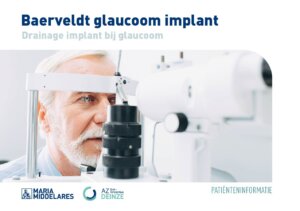Baerveldt glaucoma implant
What is it?
What is it?Glaucoma is an eye disease where a person gradually loses fibres of the optic nerve, usually due to elevated eye pressure. The Baerveldt glaucoma implant is a glaucoma surgery that aims to reduce the eye pressure in order to preserve — though not to improve — visual acuity as much as possible. This is accomplished in approximately 75% of the patients.
Additional worsening of the visual field can seldom be completely stopped. This is, among other things, due to age-related loss of the nerve fibres. Vision will not improve, and there is no repair of the damaged nerve cells.
Additional eye drops to lower eye pressure are also necessary in approximately 75% of the patients (for either a short or long period). Some patients require a repeat surgery in certain instances (sometimes years after the first surgery). In a minority of patients, there is a possibility that a second implant will need to be placed.
The definitive result can only be known six months after the procedure, at the earliest.
What is the process?
What is the process?The surgery itself
Glaucoma surgery is performed using local or general anaesthesia.
The Baerveldt drainage implant consists of an artificial little tube with a silicone plate attached. The little tube is placed into the anterior chamber of the eye. A piece of donor sclera is stitched on to the posterior surface of the eye.
The surgery takes approximately an hour and often ends with an injection of anti-inflammatory medication in the lower portion of the eye. For this reason, you may see a white area in your vision for a while.
After the surgery
When you look in the mirror, you will see the donor sclera in the upper portion of your eye. It will look like a tiny rectangle. The tube is closed shut with a suture that dissolves on its own six-to-eight weeks after the surgery. The plate is not visible and is located towards the back and on the sclera. The body produces a reaction to the connective tissue that surrounds the plate. It takes approximately six weeks for this connective tissue to form. The connective tissue ensures a certain resistance so that not too much aqueous humour is drained from the eye, which could lead to eye pressure that is too low. If the tube opens up again six-to-eight weeks after the surgery, the aqueous humour is drained towards the plate that is now secured by connective tissue. The eye pressure is reduced.
Post-operative check-ups
The first check-up takes place in the hospital the day after the surgery. The operated eye is examined and eye pressure is measured. In general, we adhere to the following check-up schedule:
- 1 week after the surgery
- 3-4 weeks after the surgery
- 2-3 months after the surgery
We always book the first appointment and the appointment after 1 week and then after 3-4 weeks before the surgery takes place. After all, they are crucial.
Side effects and risks
Side effects and risksAfter the surgery, you will barely feel any pain in your eye. The placement of a drainage implant is invasive. This may lead to eye pressure that is too high or too low or to other eye health symptoms and problems. The first few months after the surgery, you will need to administer eye drops often — even more often than before. During the few weeks or months after the surgery, you will probably see less well than you did before.
The most common side effects or risks with this surgery are:
- Double vision
- Clouding of the cornea
- Reduced vision
- Elevated eye pressure
- Eye pressure that is too low
- Exposed tube
- Deformed pupil as a result of the tube
As with any surgery, the placement of a drainage implant carries risks, such as vision loss caused by bleeding or infection. Fortunately, the chance of this happening is very low.
More detailed information about the pre-operative preparation and post-operative care can be found in the leaflet below.
Only available in Dutch:

Baerveldt glaucoom implant - Drainage implant bij glaucoom
DownloadCentres and specialist areas
Centres and specialist areas
Something wrong or unclear on this page? Report it.
Latest publication date: 13/08/2024
Supervising author: Dr. Vanwynsberghe David





